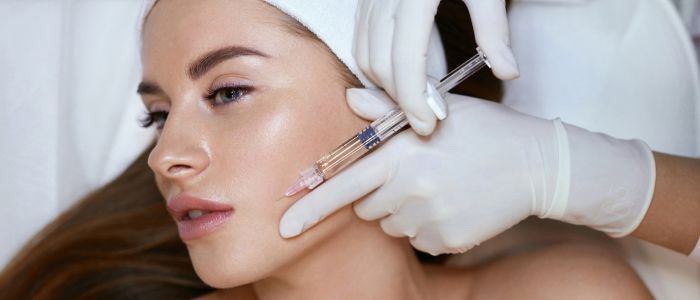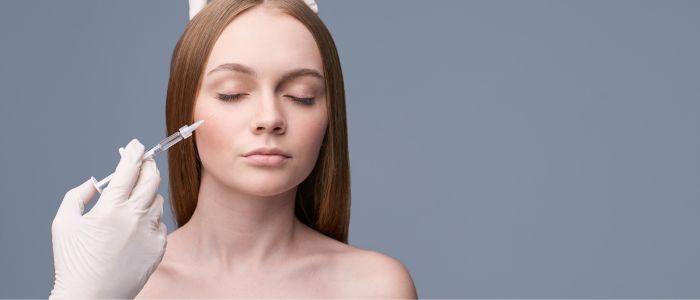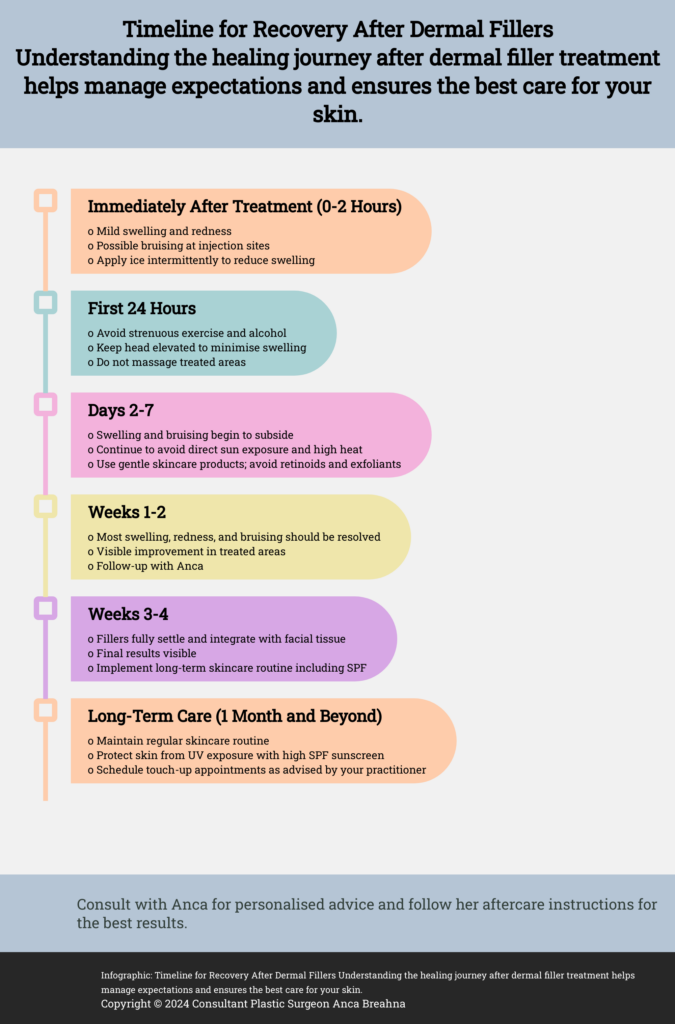
Table of Contents
- What to Expect after Getting Dermal Fillers
- Dermal Fillers Immediate Aftercare
- First Few Hours Post-Treatment
- First 24 Hours
- The Recovery Process after Getting Dermal Fillers
- First Week
- Long-Term Care after Dermal Fillers
- Potential Side Effects and Complications during Recovery after Dermal Fillers
- Common Side Effects
- Rare Complications
- FAQs about Recovery after Dermal Fillers
- Further Reading about Injectables with Consultant Plastic Surgeon Anca Breahna
What to Expect after Getting Dermal Fillers
When it comes to cosmetic enhancements, dermal fillers stand out, offering a minimally invasive solution for those looking to defy the signs of ageing and embrace a more rejuvenated appearance. These gel-like substances, skilfully injected beneath the skin, work wonders in smoothing wrinkles, plumping up hollow areas, enhancing facial contours, and improving the appearance of scars, without the need for surgical intervention. As society’s quest for eternal youth continues unabated, the popularity of non-surgical cosmetic procedures like dermal fillers has surged, reflecting a growing trend towards treatments that offer significant results with minimal downtime.
Dermal fillers, composed of substances that mimic the body’s natural collagen production, such as hyaluronic acid, provide a temporary but impactful enhancement to the skin’s appearance. They are celebrated not only for their aesthetic benefits but also for their ability to instil confidence in individuals, helping them feel more comfortable in their skin. In this blog, Consultant Plastic Surgeon Anca Breahna aims to help you understand what to expect after getting dermal fillers to have a smooth, comfortable healing process and to maximise the longevity of the results.
Dermal Fillers Immediate Aftercare
First Few Hours Post-Treatment
The first few hours post-treatment are critical for ensuring optimal outcomes and minimising the risk of complications. You will be advised to apply ice to the treated area intermittently—about 15 minutes on, 15 minutes off—to help reduce swelling and alleviate discomfort. It’s also important to avoid applying makeup or engaging in any activity that could introduce bacteria to the injection sites, thereby preventing infection.
Activities that increase blood flow to the face, such as strenuous exercise, sauna use, or consuming alcohol, should be avoided for at least 24 hours post-treatment. These activities can exacerbate swelling and bruising and may affect the settling of the fillers in the skin.
First 24 Hours
The first day after receiving dermal fillers is often when patients notice the most significant side effects, including redness, swelling, tenderness, and in some cases, bruising at the injection sites. These reactions are normal and are the body’s natural response to the injection process. To manage these side effects, continue applying ice to the area as needed and consider taking over-the-counter pain relievers, such as acetaminophen, to alleviate discomfort. However, it’s essential to avoid non-steroidal anti-inflammatory drugs (NSAIDs) like ibuprofen, as they can increase the risk of bruising.
You will be encouraged to sleep with your head elevated the first night after treatment to help reduce swelling. Additionally, gentle facial movements are recommended, but it’s important to avoid massaging or applying pressure to the treated areas unless directed by your practitioner, as this can cause the fillers to shift.
While it may be tempting to scrutinise every change or sensation in the treated areas, patience is important. The initial swelling and bruising will subside, revealing the true effects of the dermal fillers in the days to follow.
The Recovery Process after Getting Dermal Fillers
First Week
As the initial 24 hours post-treatment give way to the subsequent days, patients usually observe a noticeable decrease in swelling and bruising, marking the beginning of the healing process. This period is important as the dermal fillers settle into their final position, and the body adapts to the new contours of the treated areas. It’s a time of transformation, where the initial discomfort and visible side effects gradually diminish, revealing the preliminary results of the procedure.
During the first week, make sure to maintain a gentle skincare routine that supports healing. You should continue to avoid any harsh treatments or products that could irritate the skin, such as exfoliants or retinoids. Instead, focus on hydration—both internally by drinking plenty of water and externally by applying a gentle, hydrating moisturiser. Hydrated skin not only heals better but also enhances the overall effect of the fillers, contributing to a smoother, more youthful appearance.
Sleeping patterns during this period also play a significant role in the healing process. Continuing to sleep with the head elevated can further help reduce residual swelling. Additionally, you will be advised to sleep on your back if possible, to avoid putting pressure on the treated areas, which could potentially displace the fillers.
By the end of the first week, most of the immediate side effects should have subsided, and you can start to appreciate the effects of the dermal fillers. However, it’s important to remember that the final results may not be fully visible until a few weeks after the treatment, as the fillers continue to integrate with the natural tissue and the body completes its healing process.
Long-Term Care after Dermal Fillers
To maximise the longevity of dermal filler results and maintain the health of the treated skin, a dedicated long-term care routine is essential. Sun protection is paramount; UV exposure can not only accelerate the ageing process but also degrade the fillers more quickly. You should apply a broad-spectrum sunscreen daily, reapplying as necessary, especially if spending extended periods outdoors.
A consistent, gentle skincare routine tailored to the individual’s skin type can also extend the life of dermal fillers. Products rich in antioxidants, such as vitamin C and E, can protect the skin from environmental damage, while those containing hyaluronic acid can help maintain hydration levels, complementing the hydrating effects of the fillers.
Regular follow-up appointments with Anca are crucial for assessing the condition of the fillers and planning any necessary touch-ups. These sessions provide an opportunity to address any concerns and ensure that the results continue to meet your expectations.
Potential Side Effects and Complications during Recovery after Dermal Fillers
Common Side Effects
While dermal fillers are generally safe, understanding and recognising common side effects is important for patients. Many post-treatment concerns can actually be minimised by following proper pre-treatment steps. Take a moment to review The Do’s and Don’ts of Preparing for Cosmetic Injections to learn how preparation plays a key role in your recovery experience. Aside from the initial swelling, redness, and bruising, some individuals may experience itching or slight discomfort at the injection sites. These symptoms are typically mild and resolve on their own within a few days to a week.
Lumps or bumps may also form as the filler settles. In many cases, these can be massaged gently if recommended by Anca, and they usually diminish as the filler integrates with the tissue.
Rare Complications
Though rare, there are more serious complications associated with dermal fillers that require immediate medical attention. Infection, although uncommon, can occur and may present as increased pain, swelling, redness, or warmth in the treated area, sometimes accompanied by fever.
Another rare complication is filler migration, where the filler moves from the original injection site to another area of the face. This can alter the intended aesthetic outcome and may require professional intervention to correct.
Navigating the journey of dermal fillers, from the initial decision-making process through the treatment and into the healing phase, requires a complex understanding of what to expect. The immediate aftercare and the first week post-treatment are essential for ensuring a smooth healing process and setting the stage for the long-term maintenance of the results. By adhering to the recommended aftercare instructions, engaging in a consistent skincare routine, and protecting the skin from environmental damage, you can enjoy the rejuvenating effects of your dermal fillers for as long as possible.
Equally important is being aware of the potential side effects and complications, however rare, and knowing when to seek professional advice. With the right care and attention, the journey with dermal fillers can be a rewarding experience, leading to enhanced self-confidence and satisfaction with one’s appearance.
FAQs about Recovery after Dermal Fillers

How long do dermal filler results typically last?
The longevity of dermal filler results can vary significantly depending on the type of filler used, the area treated, and your metabolism. Hyaluronic acid fillers, one of the most common types, usually last between 6 to 18 months. Fillers used in areas with less movement, such as the cheeks, may last longer, while those in areas with more movement, like the lips, may dissipate more quickly. Anca can provide more specific guidance based on the fillers used and your unique circumstances.
Can dermal fillers be reversed or removed?
Yes, one of the advantages of hyaluronic acid-based fillers is that they can be dissolved with an enzyme called hyaluronidase. This allows for adjustments if the results are not as expected or if there’s a desire to return to the pre-treatment appearance. It’s important to note that not all fillers are reversible; therefore, discussing your options and any concerns with Anca beforehand is crucial.
Are there activities or products to avoid after getting fillers?
To ensure the best possible results and minimise complications, there are several recommendations to follow post-treatment. Avoiding strenuous exercise, excessive heat (such as saunas or hot yoga), and direct sun exposure for at least 24 to 48 hours can help reduce swelling and bruising. It’s also advisable to avoid alcohol and blood-thinning medications or supplements for a few days before and after treatment to decrease the risk of bruising. Anca may also recommend avoiding certain skincare products that could irritate the treated area for a short period.
Is there anyone who should not get dermal fillers?
While dermal fillers are safe for most people, there are certain conditions and situations where caution is advised or they may not be recommended. Pregnant or breastfeeding women, individuals with certain autoimmune diseases, or those with allergies to filler components should avoid treatment. Also, if you have an active skin infection or inflammation near the intended treatment area, it’s best to wait until these conditions have resolved. A thorough consultation with Anca will help determine if dermal fillers are suitable for you.
Do dermal fillers hurt?
Most patients report a mild to moderate discomfort during the injection process. Anca often uses fillers that contain lidocaine, a local anaesthetic, to minimise pain during the procedure. Additionally, topical numbing creams can be applied beforehand to reduce discomfort. The sensation is usually described as a brief pinch or pressure at the injection site.
Can dermal fillers look natural?
The goal of skilled practitioners is to enhance your features in a way that looks natural and harmonious with your overall facial structure. The key to achieving natural-looking results is moderation and selecting the right type and amount of filler for your specific needs. A detailed consultation with Anca to discuss your aesthetic goals is essential in ensuring outcomes that both of you are happy with.
How do I choose the right practitioner for dermal fillers?
Look for a licensed healthcare professional with extensive experience in administering dermal fillers, such as a plastic surgeon. Research their credentials, read reviews, and look at before-and-after photos of their work. A reputable practitioner will offer a thorough consultation to discuss your goals, concerns, and the details of the procedure, including potential risks and aftercare instructions.
Medical References about Dermal Fillers
- Injectable Dermal Fillers Don’t Just Fill – They Also Lift – American Society of Plastic Surgeons
- Dermal Fillers: Types, Indications, and Complications – ScienceDirect
- Evaluating hyaluronic acid dermal fillers
- Dermal fillers in aesthetics
- Practical Guidelines for Hyaluronic Acid Soft-Tissue Filler Use in Facial Rejuvenation
Further Reading about Injectables with Consultant Plastic Surgeon Anca Breahna
- Read more about Avoiding and Managing Complications of Dermal Fillers
- Read more about Where to Get Skin Relaxing Injections in Chester
- Read more about What Is the Best Anti-Ageing Wrinkle Treatment
- Read more about How to Treat Marionette Lines
- Read more about Dermal Fillers Removal – How Do They Work?
- Read more about Dermal Filler Clinic in Chester
- Read more about Dermal Fillers for Hands – Restoring Volume and Reducing Signs of Ageing








